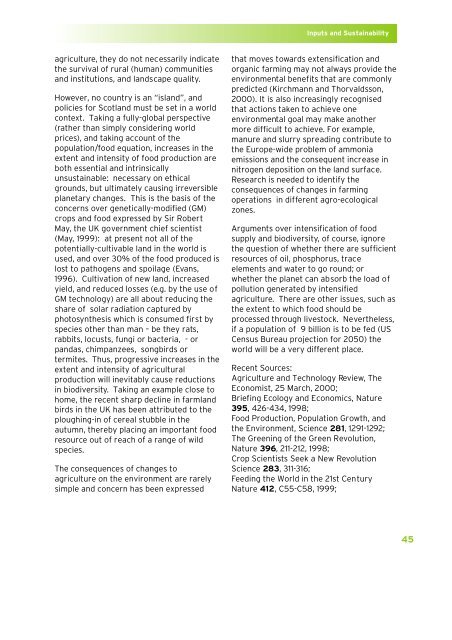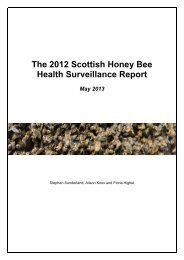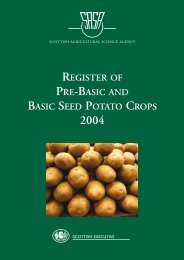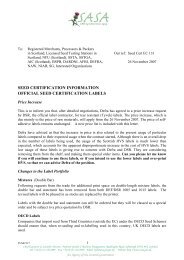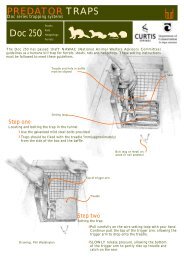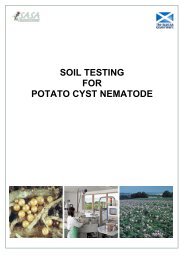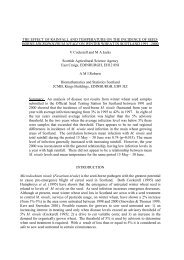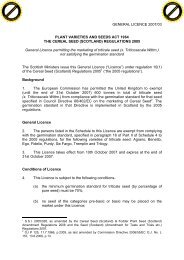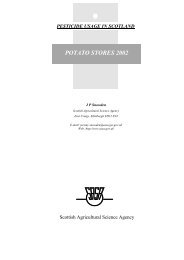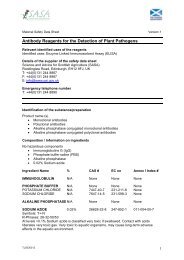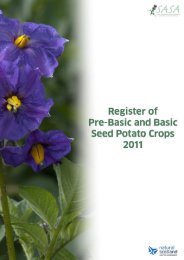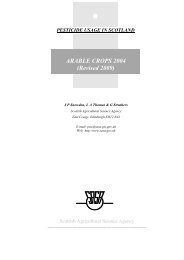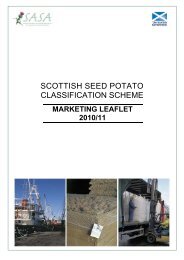Create successful ePaper yourself
Turn your PDF publications into a flip-book with our unique Google optimized e-Paper software.
Inputs and Susta<strong>in</strong>abilityagriculture, <strong>the</strong>y do not necessarily <strong>in</strong>dicate<strong>the</strong> survival <strong>of</strong> rural (human) communitiesand <strong>in</strong>stitutions, and landscape quality.However, no country is an “island”, andpolicies for <strong>Scotland</strong> must be set <strong>in</strong> a worldcontext. Tak<strong>in</strong>g a fully-global perspective(ra<strong>the</strong>r than simply consider<strong>in</strong>g worldprices), and tak<strong>in</strong>g account <strong>of</strong> <strong>the</strong>population/food equation, <strong>in</strong>creases <strong>in</strong> <strong>the</strong>extent and <strong>in</strong>tensity <strong>of</strong> food production areboth essential and <strong>in</strong>tr<strong>in</strong>sicallyunsusta<strong>in</strong>able: necessary on ethicalgrounds, but ultimately caus<strong>in</strong>g irreversibleplanetary changes. This is <strong>the</strong> basis <strong>of</strong> <strong>the</strong>concerns over genetically-modified (GM)crops and food expressed by Sir RobertMay, <strong>the</strong> UK government chief scientist(May, 1999): at present not all <strong>of</strong> <strong>the</strong>potentially-cultivable land <strong>in</strong> <strong>the</strong> world isused, and over 30% <strong>of</strong> <strong>the</strong> food produced islost to pathogens and spoilage (Evans,1996). Cultivation <strong>of</strong> new land, <strong>in</strong>creasedyield, and reduced losses (e.g. by <strong>the</strong> use <strong>of</strong>GM technology) are all about reduc<strong>in</strong>g <strong>the</strong>share <strong>of</strong> solar radiation captured byphotosyn<strong>the</strong>sis which is consumed first byspecies o<strong>the</strong>r than man – be <strong>the</strong>y rats,rabbits, locusts, fungi or bacteria, - orpandas, chimpanzees, songbirds ortermites. Thus, progressive <strong>in</strong>creases <strong>in</strong> <strong>the</strong>extent and <strong>in</strong>tensity <strong>of</strong> agriculturalproduction will <strong>in</strong>evitably cause reductions<strong>in</strong> biodiversity. Tak<strong>in</strong>g an example close tohome, <strong>the</strong> recent sharp decl<strong>in</strong>e <strong>in</strong> farmlandbirds <strong>in</strong> <strong>the</strong> UK has been attributed to <strong>the</strong>plough<strong>in</strong>g-<strong>in</strong> <strong>of</strong> cereal stubble <strong>in</strong> <strong>the</strong>autumn, <strong>the</strong>reby plac<strong>in</strong>g an important foodresource out <strong>of</strong> reach <strong>of</strong> a range <strong>of</strong> wildspecies.The consequences <strong>of</strong> changes toagriculture on <strong>the</strong> environment are rarelysimple and concern has been expressedthat moves towards extensification andorganic farm<strong>in</strong>g may not always provide <strong>the</strong>environmental benefits that are commonlypredicted (Kirchmann and Thorvaldsson,2000). It is also <strong>in</strong>creas<strong>in</strong>gly recognisedthat actions taken to achieve oneenvironmental goal may make ano<strong>the</strong>rmore difficult to achieve. For example,manure and slurry spread<strong>in</strong>g contribute to<strong>the</strong> Europe-wide problem <strong>of</strong> ammoniaemissions and <strong>the</strong> consequent <strong>in</strong>crease <strong>in</strong>nitrogen deposition on <strong>the</strong> land surface.Research is needed to identify <strong>the</strong>consequences <strong>of</strong> changes <strong>in</strong> farm<strong>in</strong>goperations <strong>in</strong> different agro-ecologicalzones.Arguments over <strong>in</strong>tensification <strong>of</strong> foodsupply and biodiversity, <strong>of</strong> course, ignore<strong>the</strong> question <strong>of</strong> whe<strong>the</strong>r <strong>the</strong>re are sufficientresources <strong>of</strong> oil, phosphorus, traceelements and water to go round; orwhe<strong>the</strong>r <strong>the</strong> planet can absorb <strong>the</strong> load <strong>of</strong>pollution generated by <strong>in</strong>tensifiedagriculture. There are o<strong>the</strong>r issues, such as<strong>the</strong> extent to which food should beprocessed through livestock. Never<strong>the</strong>less,if a population <strong>of</strong> 9 billion is to be fed (USCensus Bureau projection for 2050) <strong>the</strong>world will be a very different place.Recent Sources:Agriculture and Technology Review, TheEconomist, 25 March, 2000;Brief<strong>in</strong>g Ecology and Economics, Nature395, 426-434, 1998;Food <strong>Production</strong>, Population Growth, and<strong>the</strong> Environment, Science 281, 1291-1292;The Green<strong>in</strong>g <strong>of</strong> <strong>the</strong> Green Revolution,Nature 396, 211-212, 1998;<strong>Crop</strong> Scientists Seek a New RevolutionScience 283, 311-316;Feed<strong>in</strong>g <strong>the</strong> World <strong>in</strong> <strong>the</strong> 21st CenturyNature 412, C55-C58, 1999;45


